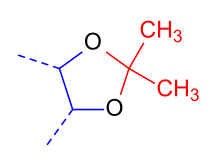Acetonide
In organic chemistry, an acetonide is the functional group composed of the ketal of a diol with acetone. The more systematic name for this structure is an isopropylidene ketal. It is the most common protecting group for 1,2- and 1,3-diols.[1] The protecting group can be removed by hydrolysis of the ketal using dilute aqueous acid.
Corticosteroid acetonides are used pharmaceutically, especially in dermatology, because their increased lipophilicity leads to better penetration into the skin.[2]
An example of its use as a protecting group in a complex organic synthesis is the Nicolaou Taxol total synthesis. It is a common protecting group for sugars and sugar alcohols, a simple example being solketal.
References
- ↑ Kocieński, Philip j. (1994). "3.2.2: Diol Protecting Groups—Acetals—Isopropylidene Acetals". Protecting Groups. Foundations of Organic Chemistry Series. Thieme. p. 103.
- ↑ Steinhilber, D; Schubert-Zsilavecz, M; Roth, HJ (2005). Medizinische Chemie (in German). Stuttgart: Deutscher Apotheker Verlag. p. 337. ISBN 3-7692-3483-9.
This article is issued from Wikipedia - version of the 7/6/2013. The text is available under the Creative Commons Attribution/Share Alike but additional terms may apply for the media files.
